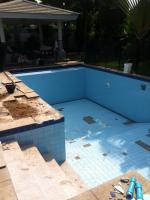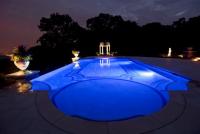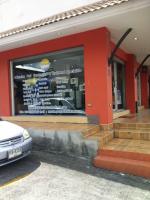
PoolDoctor
-
Posts
157 -
Joined
-
Last visited
Content Type
Events
Forums
Downloads
Quizzes
Gallery
Blogs
Posts posted by PoolDoctor
-
-
I am not a big fan of replacing my salt water cell every 2-3 years, so I keep chlorine production down with external CYA. Here is a technical data sheet from AquaCheck detailing the importance of CYA. Just because people don't know about it, doesn't diminish the need for it.
-
I can't see anyone wanting to lay back a huge stock of CYA at those prices. 6 drums is probably more than the entire demand in Thailand for one year (or even more). For those using salt water chlorinators, for a medium sized pool just adding the occasional TCCA tablet or some granules will probably supply all the CYA that's needed. It's also a good idea to set the pumping times during the evening. Be better to invest in a cheap CYA test kit first and see what is really needed.
At what prices? Also, one drum is 44kg. Are you saying all of Thailand only uses 264 kg of CYA per year?
-
I'm not sure who is responsible for replacing the bulbs in the View Talay 2a pool, but no fewer than 4 bulbs have been out for over 4 months. If it is the company who repaired the pool last year, then this is very poor after sales service!
The pool deck has, since it was redone last year, has developed several cracks which are going to need attention again very soon. I have to say I am not impressed with the standard of work!
A concerned co-owner..
If you are concerned, you should get onto the committee then and start helping to manage the building. We quoted the replacement bulbs but it was not approved. We also expressly informed the building prior to the job that there was settlement happening around the pool. Obviously, a thin layer of gravel wash will crack if its installed onto a settling or dynamic base. Those tiny cracks are minor anyhow, and the deck is light years better than it was when it had the highly dangerous and slippery slate inlays in place. I believe you are losing sight of the forest for the trees.
-
Actually, we have used both grades of PVC quite successfully for a long time. Yes, 13.5 is nice, but sometimes in a cramped corner turn we have to use the lower grade because the 90 degree bends are shorter. Anybody who has done plumbing will know what I mean. If underground, use 13.5, but anything else is generally ok if in the equipment room. Pool systems operate to about max 11psi which is well within the pressure guidelines of most glued PVC. We never clean with acetote or anything, we just make sure the connection is dry, and deep (pre-marked with a marker line assembled, then separated for the actual gluing.
-
A client of ours wants to sell up to 6 drums of spare cyuranic acid. 44kg each drum, 100% CYA stabilizer for salt water pools or liquid chlorine pools. Can be piecemeal or together. A good price for hard to find pure CYA. It does not evaporate by the way, top it up only 1x per 3 months or so.
If you don't know, CYA is second only to salt in importance for salt water pools. Why? The chlorine from a generator is unstabilized, and flashes off quickly. This makes the generator work harder to maintain an acceptable free chlorine level. Stabilize it with CYA, and then drop the production rate down significantly, lengthening the lifetime of your cell. My pool uses a tiny generator (5x10m pool) and even at 2-3 meters away, I can whiff chlorine due to nice CYA levels. I keep production at 40% and the Zodiac cell is 6 years old with no sign of giving up. Anyway, PM me if interested or [email protected]; as a favor to my client we will deliver to anywhere in BKK or Pattaya.
Gil
-
It all depends on the size and shape of the pool and if you have already made your mind up on the finish you require. Some tiles for example can take up to three weeks to deliver when ordered from the factory. If it's a straightforward rectangular pool, there is very little design time involved. If all materials are available ex stock, from breaking ground to completion and filled, reckon on about 3 - 4 weeks for a typical 4 x 10 in-ground, concrete pool, fully tiled.
It will be a small regular rectangular pool of 4x6 so nothing really special.
What would be the points I have to look out for?
Even for that small size, I would say it cannot be done. Pilings alone would take a week to arrange and complete. Then, excavation, setting forms, lean concrete, etc. Smaller pools are not necessarily easier, due to limited working space afforded to the team.
-
We stock and carry removable pool safety fencing. We have also done several installations in Phuket, driving down from BKK. PM me at anytime, post here, or see our website with tons of references and photos.
Gil
-
A 8x24x2 (2m avg depth) pool has 384,000 liters. If its an overflow pool, add 5% for the surge tank. A good guess is 400,000 liters, or 400 m3. Tap water in Thailand is about 17 baht per m3, so filling by hose would be about 7,000 baht. Extremely slow. On the other hand, ordering trucks (small size) in Pattaya is 200 baht per 2,000 liters or .10 baht per liter. This translates to 100 baht per m3, a huge difference. Baht 40,000 to fill this pool using water trucks in Pattaya. BKK is even more expensive. Then, you will need salt of course, alkaline, and cyuranic acid (which stabilizes the chlorine being produced by the chlorinator). Your first reaction might be <deleted>?? Fire him. Then again, its not easy to find capable and diligent pool people in Thailand anymore (actually never was). Motorcycle taxis easily get 500-600 per day doing mostly what they do anyhow (scream around on motorbikes) and asking a Thai to clean a pool 3x per week with chemicals knowledge mastery is like asking the U.S. to hold off on war for a couple of years. You might try asking him to pay it off slowly; if he's a good guy, he'll agree to it.
-
 1
1
-
-
In over 11 years of doing pool work in Thailand, we have amassed a huge knowledge bank of tips and tricks that we use routinely in the field. E.g., wrap the foot valve pipe in green chicken mesh and secure it with cable ties to prevent leaf clogging. This is just an example, and we have hundreds more. To help make pool ownership and care in Thailand a bit easier, we are posting these tips and tricks on our facebook page. They will be called "Tip of the Week" so imaginatively name. Lol. We hope you like them, and if you have any questions don't hesitate!
Gil
-
Several months ago, the multiport valve on my sand filter stuck, and wouldn't budge. I then tried to unbolt it off the filter and disassemble and clean. Loh and behold, one of the retaining bolts snapped due to rust / age, and I was left with a perfectly useless filter. As it was approaching cold season, I just let the pool go. To keep mosquitos down, I dumped in granular chlorine intermittently for 3 months or so.
Finally got around to changing the filter, and after draining the pool - bam. NO grout, and LOTS of lifting tiles. Here is a picture. dam_n. I myself went against everything that we preach here. Lol. I feel like that medical doctor who scolds his patients, but if you look closely, you can see his nicotine fingers!
Moral of the story - stay away from granular chlorine! Its not so painful for me to fix, as my guys are employees, but this could be a significant cost for any homeowner.
Picture here.
Gil
-
This is somewhat of a complicated equation. Why? Because there are a number of variables for the inputs. E.g., what is the maximum expected pool load (each person displaces 35 liters about), surface area exposure to rain (1 cm rain fall over a 8mx12m pool displaces about 960 liters), etc. Then, there is the distance from the pump to the pool - e.g., how quickly is the water drawn from the tank, and sent back to the pool so that it starts overflowing again. The shorter that distance, the less "buffer" water needed in the tank or catch basin.
We design the infinity catch tank to accomodate enough water, but as you said, not too much to lead to overflowing into the garden, causing erosion, loss of chemicals, etc. Finally, there is a "fudge factor" that we build in based on our own experience. Then, there is the length and height of the spill weir, which takes up water as it cascades. All of this, we have captured in our own spreadsheet.
PM me if you need.
Gil
The Pool Doctors
-
I have a Zodia Tri Ph large installed for almost a year and have no problems.My Ph is a constant 7.3 and my chlorine levels are adequate, however I would like to learn how to check CYA levels once without spending thousands on such a taylor kit.
Sounds like the Zodiac is doing its job nicely. You can easily check CYA using inexpensive litmus strips. They check free chlorine, pH, CYA, alkaline, and hardness. Available at any good pool shop that understands chemistry.
Gil
-
Hi All,
We will be installing a salt water treatment system shortly, in a residential pool. The pool owner specifically requested the Zodiac Tri with built-in pH injector. Hmn. Where did he learn that we wonder? Turns out, he is an engineer. So, I thought I would post a bit of info here on why a pH injector is also required in a salt water pool.
A salt water treatment system converts via electrolysis the salt [sodium chloride] in the pool water to a gaseous form of hypochloric acid. HA is the killing form of chlorine, and this chlorine gas effectively oxidizes (or sanitizes) any foreign contanimation in the water (e.g., bacteria, viruses, water borne pathogens).
The problem is, this process of converting the salt to chlorine tends to make the pH rise over time (any further explanation here gets VERY technical, beyond the scope of this post). The salt in the water also contributes to the pH drifting upwards. Why is this a problem?
Because, the efficiency (ORP to be exact) of chlorine is inversely related to pH. At high pH levels, ORP (oxidation reduction potential) declines SIGNIFICANTLY. Some estimates are, that at 8.0 ph, chlorine is only oxidizing at 20% potential. This means, even if you have high ABSOLUTE levels of chlorine in the water, that chlorine might only be working at a small fraction of its potential. This problem is further exacerbated by most homeowners not knowing that they need additional chlorine stabilizer in the water (cyuranic acid) to counteract rapid evaporation of chlorine gas. Voila - high pH, and no CYA = problem. This is where 90% of the complaints come from with regards to salt water chlorinators and commercial liquid chlorine pools (liquid chlorine is also un-stabilized).
Lesson - keep the pH down with a pH injector, and stabilize your pool water at 30-50ppm cyuranic acid. End of problem, and very nice high ORP. Safe water!
Gil
-
Hi All,
A topic that tends not to get a lot of attention is, underwater lighting. This is one of the easiest and fastest ways of improving your pool's look at nighttime.
Years ago, I would cringe when a client rang us about lighting. Why? Traditional halogen bulbs burn hot, and then cool down when turned off. This cycling of hot / cool or more precisely expansion / contraction of the housing would inevitably cause water leaks in a large number of underwater lights. Nothing is worse than having to replace a light 11 months into a 12 month warranty! Lol.
These days though, we are pleased to install LED lights, which don't create much heat. The technology has really come up, and now we can offer lights with 10 different colors, patterns, strobe effects, etc without having to worry too much about leaks. Please note that all older pools are also available for a retro-fit and can easilty accomodate LED technology. The different colors are truly spectacular, and the 20w output is really sufficient for most residential pools.
The best part? You no longer have to go into the equipment room to turn them on! We offer a very economical remote control option which permits turning on the lights from the comfort of your living room (some distance constraints). Give us an email at anytime for more information, or a hassle-free quote. We can also install a variety of perimeter (e.g., garden) lighting systems.
Best,
Gil
-
Best to do it yourself, pick up an auto cleaning robot. When combined with a sand filter, and salt chlorinator, maintenance then becomes almost nil. The robot does the vacuuming, the chlorinator manages the chlorine, and the filter is maintenance free (save for a quick back flush 2x per year).
Gil
-
Just a quick note here to let everyone know that we offer a free online pool monitoring service via our website. This is how it works. The pool technician tests and monitors the pool on site, and inputs the data (ORP, pH, Alk, CYA, Hardness) into our live site daily. No news is good news. However, anytime the technician inputs data that falls outside of our set parameters (e.g., CYA between 30-150ppm) an alarm email is triggered to 2 places automatically - 1) us, 2) the client's management office). This allows rapid intervention, and sufficient time to correct a problem before it worsens. ORP and pH are measured digitally, reducing the ability of the pool technician to out right lie.
As an example, we monitor a large commercial pool down the road from us daily. Over the last 2 service times, ORP has been declining. Their pool has about 1.5m liters of water, so if it goes green, its a hassle over the New Year (the management company will surely be called to explain). This morning, we sent an email to the building manager to find the cause of the problem, and to correct immediately by today. I don't have the root cause back yet, but I'll post here later as a follow up. I think that this system is light years ahead of anything else available, and we make it absolutely 100% free to use by any client out there. Email us if you wish us to monitor your pool at no charge / obligation. Attached here is the screen shot of the data.
I hope that we can catch this pool before it goes green, treating 1.5m liters is expensive and time consuming.
Best,
Gil
The Pool Doctors
-
A lot of the 'discussions' (sic) on this forum focuses on residential pools. However, there are a huge number of commercial pools in Thailand, and I wanted to take this time to point out some things that might benefit people who manage or run a commercial pool. Also, commercial pools affect many more people (due to the volume of users) so I thought a note about safety would be pertinent.
I am not sure how to define commercial vs. residential, other than to draw a line based on size and location. I think commercial pools fall in the realm of hotels, condo buildings, international schools, and village community buildings ("samusorn" in Thai). Many of the pool problems that we see in Thailand are caused by owners employing a local pool shop (residential pool experience) to fix or maintain their commercial pool. This is inherently wrong. Why?
Working on commercial pools is entirely different, simply due to their size, complexity, and nature of equipment. Installing a 2" valve is vastly easier than a 6" bolted butterfly valve. Working with large PVC is also difficult, and aligning a 12.5hp Calpeada pump properly requires some experience. In almost all cases also, we recommend an automated injection system (ORP & pH). When the water goes green in a house pool, its 24 - 36 hours to get it back. In a commercial pool though, its often a week (volume of water). An automated system also, will set up an alarm in advance, and provide sufficient time needed to fix an issue before it escalates. Many of our commercial pool customers upload their data onto our site daily, and we monitor their pool and step in before something goes awry with their chemistry. If you lose the grout in a 5x10 pool, not an issue. Lose it in a huge commercial pool though, and its major hassle, time, and expense.
Finally, a day does not go by that we don't see commercial pools with major safety hazards. No anti-entrapment drains, no ring buoy available, no telephone nearby, glass being used at the bar, missing tiles, missing grout, electrical hazards, the list goes on and on. Commercial pools by their nature cater to many more people, and the potential for an accident is much higher. Alas, many of the news reports of fatalities around pools involve commercial pools.
Contact us at anytime if we can be of assistance.
Gil
-
About 15 people have called us recently, looking for our office. They are also enquiring on our line of pool furniture. Here is a picture, a sample is in our showroom. We are on Soi Khao Talo, across from the big yellow Bank of Ayudhya. If you're coming by to discuss a pool question or need, make sure that I am there first ok? I am often out on sites.
For the pool safety fencing, we will have more stock this week, and I apologize for running out.
Gil
-
Lol. I can see nothing has changed on TV.
Anyway, we just finished the pool at View Talay 2, a massive pool that had serious filtration issues. Number 1 being, likely inadequate filtration capacity for that volume of water. Changing out the 6 filters though, would have been too $, and a hassle due to the entrance of the equipment room. We do know though, that zeolite has about 50% more filtering capacitiy than sand, so our idea was to increase filtration by using zeolite instead of sand and simply fill the canisters higher. Voila! We achieved crystal clear water, at a fraction of the cost of new filters. What was interesting to us also was, only a very slight increase in operating pressure (well within normal). So, we have been sold on zeolite media ever since, and I am swapping out my old sand in my house filter soon. I don't think the pea gravel is needed, I would be worried about breaking one of the spindles in the collector pipe. Of course, we also installed an automated pH and ORP injector, which helps keep water balance, which ultimately is the key to clear water.
Anyway, don't shoot The Doctor!
Gil
-
It could also this: on most control panels, there is an overload trip installed onto the bottom of the magnetic switch. If it is set too low, it will trip the system, and cause the overload to come on. Just turn the dial to the right a bit, and should solve this. As pumps get older, they draw more current (like getitng out of bed in the morning) which causes really sensitive overload settings to trip. Most pumps run at about 14amps if I am not wrong.
You will know if the bearings are gone by the way, together with your neighbors!
 If it isn't a sound like that, the bearings have little to do with it.
If it isn't a sound like that, the bearings have little to do with it. Thermal overload though, is different. A thermal overload in the pump will shut off the pump, but will not trip the overload switch in the panel. A pump runs hot (and trips the thermal shut off internal to the pump) when there is insufficient water coming into the pump.
Gil
-
Several people have been asking us where our office is. To respond, I am attaching a photo of our office. We are on Soi Khao Talo, halfway up and directly across from the big yellow Bank of Ayudya. Just next to the 7-11. This is where we have the show unit for the auto cleaner (water tank), and some show pieces of the all weather furniture.
Come by for a coffee anytime (call me to make sure I'm there), and we can discuss your pool needs. I'll do some trouble-shooting for you also, and help explain water chemistry if needed. Anyone coming by also, can pick up a CD with our free water chemistry manual included (Thai or English version). Only for Thai Visa members!

Best,
Gil
-
We have just concluded a dealer agreement also, with one of the better known heat pump manufacturers for swimming pools.
We now have a complete line, from units that are good for small residential pools, all the way up to large commercial pool applications. Just recently, we installed 2 large units are the Russian Embassy, BKK.
There is nothing like a heated pool in the cold season in Thailand.
Kind regards,
Gil
The Pool Doctors
-
Thank you Michael, I just saw this. On behalf also of my employees, I would like to thank you for employing us. The project was fun, your pool is amazingly huge. It was humbling just to stand in it while empty, and look around saying to myself..."how the hell am I gonna pull off this project??" Lol.
To all that are interested, this pool now uses an automated pH and ORP measurement & liquid chlorine dosing system. Both the pH and the ORP level (google it) are measured in real time digitally. Via a SEIKO control panel unit, dosing pumps are operated automatically when either the pH or the ORP goes out of range. We installed the chemical tanks OUTSIDE of the equipment room to prevent damage due to the equipment, and to facilitate ease of topping up. We changed out the pumps, repaired the filters, and used Zelbrite media (much higher filter area in the same filter tank). New LED lights, grout, tile repair, tank repair, gutter repair, etc., and finally gravel washed the deck. After the gravel wash was completed, we sealed the deck with a nano-tech water proofing agent. All in all, the effect was quite nice. One nice touch was, we installed anti-entrapment main drain covers for safety.
If anyone out there is interested in a similar commercial grade system for their condo pool, please reach us at anytime. If you continue to throw granular chlorine into your pool, you'll be ringing somebody for a grout job shortly!
Best,
Gil
-
Just a quick follow up to this, we can arrange an on site demo for serious customers. Just let us know when and where, and we'll be at your pool with a demo unit.
Gil






Spare cyuranic acid
in Swimming Pool Forum
Posted